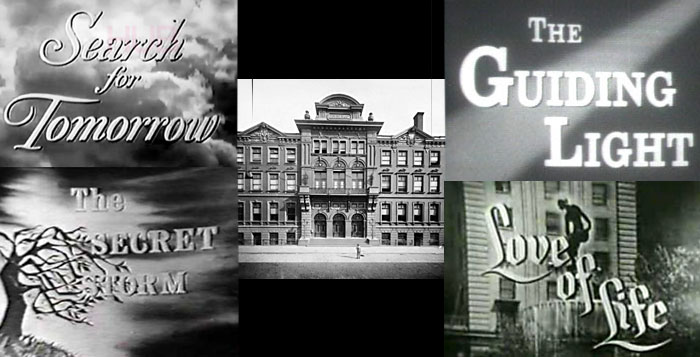Warner Brothers. Metro-Goldwyn-Mayer. Paramount Pictures. 20th Century Fox. Liederkranz Hall. The first four are well-known studios that brought some of the most famous moving pictures to life. And though some have been dismantled, they are still forever immortalized in the annals of history. But what was Liederkranz Hall? And what did it have to do with soap operas?
Soap Operas — A Famous Address
Once upon a time, New York’s 58th Street and Park Avenue was the address of the soap opera world. Liederkranz Hall was a four-story, red brick opera house that had been built in the 1800s and was originally used as a social club for German musicians. In the early 1950s, CBS President William S. Paley turned the building into a television studio, where the network produced all of its early serials and other shows.
The building’s operatic grandeur, with its tall arched windows, marble steps, and two grand, mirror-image oak staircases that swept up from the lobby to the balcony level, was the perfect location to bring soap opera to life. The plaster may have been yellow and peeling in places and drab gray linoleum may have replaced thick red carpeting, but, as late soap legend Mary Stuart (Jo, Search for Tomorrow) wrote in her autobiography, Both of Me, “it was a real theatre, a place where dreams were born.”
Dreams and television shows. Although national network television was still in its infancy in the early 1950s and only a few million homes had sets on which to watch it, Liederkranz Hall was a “beehive” of activity. By the fall of 1951, in addition to the serials Search for Tomorrow, Love of Life, and The First Hundred Years, more than a dozen other shows “crowded each other in and out of the four [cramped] little studios” housed in the building.
Mike Wallace had a talk show. Mr. I. Magination hosted a program for kids. And every morning, Bride and Groom married a nervous couple in front of a live audience. They would be joined over the years by more soap operas (The Guiding Light, Valiant Lady, and The Secret Storm) and by television pioneers such as Ernie Kovacs and Captain Kangaroo.
With so many shows sharing the limited facilities, space was at a premium and every corner was put to use, often in more than one capacity. A basement bowling alley served as the storage area for scenery and equipment – and as a practice hall for Beat the Clock contestants. Search for Tomorrow and Love of Life had to stagger their rehearsal hours so that they could share the same tiny makeup and dressing room.
And time in the studios themselves was so limited that the sets were literally being built and lit around the actors as they rehearsed their scenes. As Stuart recalled, “In one hour every day, we built and lit the set and got all of the rehearsal we were going to get.”
The chaos and commotion in the halls added to the energy and hubbub on the set. “There were always about a half dozen kids on the combined shows,” wrote Stuart, “and the halls were open territory. If the game was cops and robbers, the water cooler and the banisters were good places to shoot from.”
“Things were always happening,” concurred Jada Rowland (Amy Ames, The Secret Storm) in Robert LaGuardia’s book Soap World. “Captain Kangaroo was right next door. An elephant ate my purse, a llama spat at Virginia Dwyer [Jane Edwards], and a cow chased our director, Gloria Monty, into the studio.”
“If you stood at the top of the stairs,” confirmed Stuart, “you never knew what was coming down the hall.”
The television and soap opera industries quickly outgrew Liederkranz’s tight quarters. Its tiny studios and bustling halls have long since given way to generic, run-of-the-mill structures. But for those who worked there, the unpredictability – and fun – of working at Liederkranz Hall lingered vividly and fondly in their memories.
